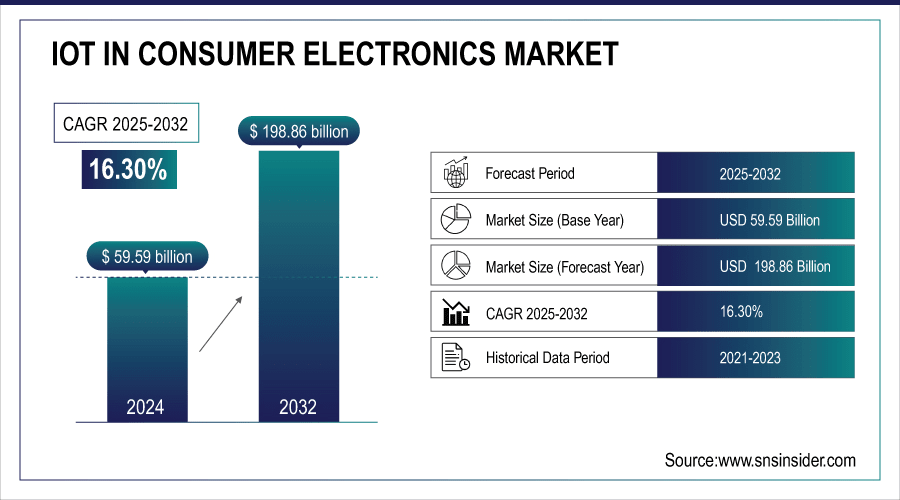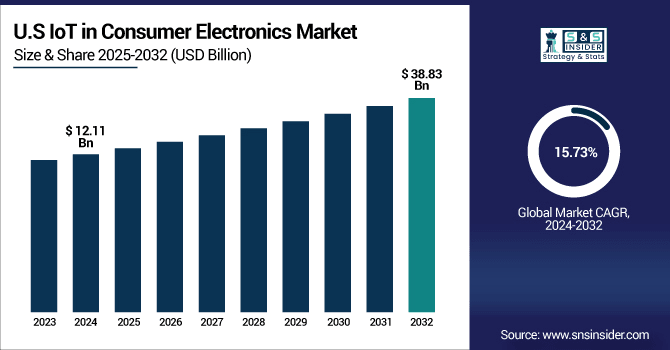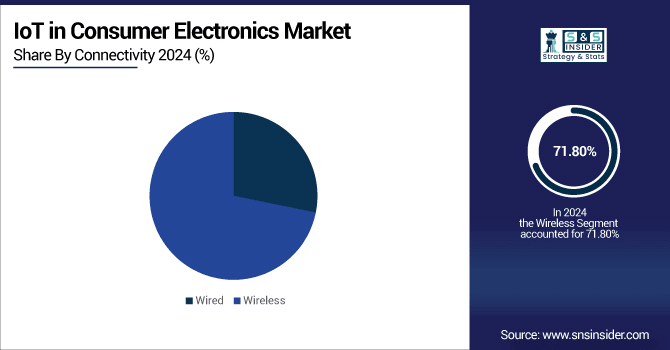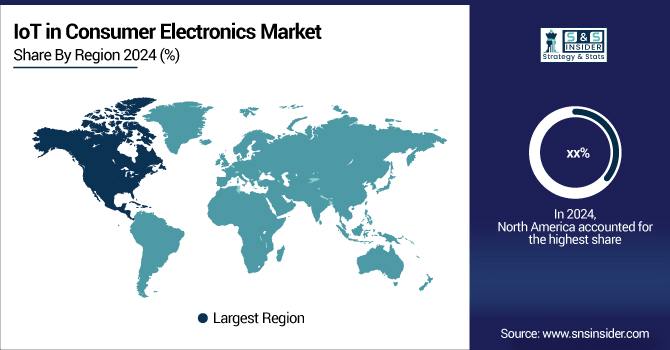IoT in Consumer Electronics Market Size & Growth:
The IoT in Consumer Electronics Market size was valued at USD 59.59 billion in 2024 and is expected to reach USD 198.86 billion by 2032 and grow at a CAGR of 16.30% over the forecast period of 2025-2032.
The global market report contains a detailed IoT in consumer electronics market analysis, including market dynamics (drivers, restraints, opportunities & challenges), market size analysis by product type, application, technology, connectivity and region. Riding on increasing AI integration, rising demand for automation, and technological acceleration in areas like wireless connectivity, adoption of IoT is soaring, making IoT a key enabling technology for the next generation of consumer electronic products globally.
For instance, shipments of AI-enabled consumer IoT devices surpassed 1.2 billion units globally in 2024, highlighting strong integration of intelligence into electronics.

To Get more information on IoT in Consumer Electronics Market - Request Free Sample Report
The U.S. IoT in Consumer Electronics Market size was USD 12.11 billion in 2024 and is expected to reach USD 38.83 billion by 2032, growing at a CAGR of 15.73% over the forecast period of 2025–2032.
The U.S. IoT in consumer electronics market is projected to witness tremendous growth during the forecast period owing to the early uptake of smart homes, ongoing penetration of wearables, and advanced wireless infrastructure, including 5G. The strong presence of global IoT innovators and high consumer spending on connected devices also continue to spur IoT in consumer electronics market growth across the region. A perpetual cycle of new technology buffered by a majority digitally-based population guarantees growth while making the U.S. one of the largest contributors to global consumer electronics IoT adoption.
For instance, more than 45% of U.S. households owned at least one wearable device in 2023, reflecting the rapid consumer shift toward connected health monitoring.

IoT in Consumer Electronics Market Dynamics:
Key Drivers:
-
Growing Adoption Of Artificial Intelligence And Data Analytics To Enhance Personalized Consumer Electronics Experiences Globally
The integration of Artificial Intelligence in IoT based consumer electronics has changed the way that these devices interact with users on a daily basis. Seamless predictive insights, recommendations, and automation powered by AI-enabled analytics and machine learning spread through an ecosystem of connected devices from a wearable to a smart kitchen appliance. Consumers demand personalized experiences among different sectors which is pushing manufacturers to enable the devices intelligence expansion through IoT. Innovations like AI-based voice assistants, next-gen healthcare wearables, and smart energy management systems indicate the personalization trend that works well with everyone. It increases consumer satisfaction, while providing alternate paths for generating revenue; thus, making the AI a key facilitator for the consumer electronics IoT market.
For instance, more than 30% of smartwatch users actively track health metrics such as blood oxygen and ECG, powered by AI algorithms.
Restraints:
-
High Concerns Over Data Privacy And Security Risks Across Consumer Electronics IoT Ecosystems Limiting Market Adoption Potential
IoT consumer electronics will still face one of the biggest obstacles to adoption from the data security perspective. From smart wearables collecting personal biometrics to home appliances monitoring power consumption, devices constantly collect and transmit sensitive data. Cyberattacks, unauthorized access, and data misuse are some of the threats to IoT systems that can arise due to weak security protocols. The increasing trend of breach cases and growing awareness among consumers regarding privacy risks hinder the adoption of IoT devices. Costs are one of the major pillars of friction in the way of widespread adoption across the global consumer electronics industry (e.g. manufacturers need to spend big bucks on proven cybersecurity before they can really start pushing it).
Opportunities:
-
Rising Demand For Healthcare Wearables And Fitness Trackers Driving IoT Integration Into Personalized Consumer Electronics Devices
Consumer electronics focused on healthcare are coming up as a new source of IoT integration growth. IoT-based wearable devices like smartwatches and fitness trackers allow real-time health status updates, remote diagnosis and personalized feedback. Increasing chronic diseases and growing health awareness creates demand for these types of devices. The addition of integration with relevant healthcare apps and telemedicine significantly increases the price of set healthcare devices. This has led a number of manufacturers and healthcare providers to capitalise on this trend by expanding IoT applications beyond entertainment and home automation, thus opening up new revenue streams and a wider adoption opportunity on a global scale.
For instance, over 60% of wearable device users sync their health data with mobile apps for personalized insights.
Challenges:
-
Lack Of Interoperability And Standardization Across IoT Consumer Electronics Platforms Restricting Seamless Device Integration And User Experience
A major issue in IoT consumer electronics is the lack of cross-device communication between devices made by different manufacturers. Seamless connectivity is crippled due to different standards and protocols, leading to fragmented ecosystems. This leads to the other biggest issue consumers have to deal with which is compatibility when integrating multiple devices with power banks resulting in decreased user satisfaction and lower adoption rates. Manufacturers have no option but to chew the bullet and innovate frameworks and interoperable ecosystems to synchronize the device bacon. Interoperability is one of the most urgent problems facing global consumer electronics adoption, as the absence of any real standardization across IoT continues to limit the potential of connected devices.
IoT in Consumer Electronics Market Segmentation Analysis:
By Connectivity
Wireless connectivity generated largest revenue share of over 71.80% In 2024, And is expected to grow at fastest CAGR Of 16.44% during 2024–2032 This is due to technologies broadly support Wi-Fi, Bluetooth, and 5G technologies for seamless connectivity and user convenience. This further cements this dominance, with companies like Qualcomm providing key wireless chipsets. Without wireless networks, there would be no real-time data exchange, no ability to remotely access information, and no need to connect a variety of devices together in a modern consumer IoT ecosystem.

By Product Type
In 2024, Smartphones accounted for the maximum revenue share of the IoT in Consumer Electronics Market pertaining to more than 34.10% of the overall market. They are the center of the IoT integration, offering the new way for connection and manageability of many smart devices above them, and this is why they dominate. This dominance would not be possible without the role of companies like Apple and the ecosystem it has built around the iPhone. Smartphones have become the backbone of IoT-driven consumer ecosystems across the world thanks to ever-cheaper internet access, their multi-function capabilities and high global penetration.
Wearable Devices is projected to witness the highest growth rate of ~17.81% during the period 2024–2032. The explosion of consumer demand for fitness tracking and real-time health monitoring and personalized digital experiences continues to fuel their rapid growth. Also, adoption is getting a boost from innovators like Fitbit (not owned by Google) in the field of AI-powered health solutions. The increasing trend of preventive healthcare and lifestyle management is poised to make wearables among the most vibrant categories of IoT products.
By Application
In 2024, personal applications accounted for the largest revenue share in the IoT in Consumer Electronics Market, which is approximately 68%. This dominance is aided by massive individual usage of smartphones, wearables, smart TV and smart home devices. Smart Home Ecosystems filled by companies like Samsung further entrenching Smart Home leadership. The dominant position of personal applications in consumer markets enabled by IoT will be further reinforced by changing consumer lifestyles with rising demand for convenience and rapid global digitalization.
The Professional segment is estimated to grow at the highest CAGR at around 16.33% during the period 2024–2032. This growth is being led by an uptick in the deployment of Internet of Things solutions in enterprises, remote operations, and smart office environments. Cisco Systems offers enterprise IoT and connected workplace solutions for productivity and efficiency. IoT is becoming more and more important in professional environments with ever-growing need for enterprise wearables, connected printers and professional automation tools while hybrid and remote work models push the adoption further.
By Technology
Artificial Intelligence (AI) held highest revenue share, more than 32.20% in the IoT in Consumer Electronics Market, and is also expected to grow at a maximum CAGR, more than 17.42% by 2024–2032. Consumer-facing IoT devices utilize AI to automate numerous tasks, provide voice commands, predictive analytics, and personalized experiences. At the hub of this dominance are the likes of Google, with its intelligence powered Google Assistant. AI stands to be, without a doubt, the most disruptive force of all consumer IoT tech, and this is because of the AI's function as the single most powerful intelligence layer that allows devices to either work collaboratively or provide additional value.
IoT in Consumer Electronics Market Regional Overview:
North America holds a significant position in the IoT in Consumer Electronics industry due to large scale adoption of smart home smart electronics, wearables and connected consumer devices. Innovation is further facilitated by the presence of tech giants like Apple, Google, and Cisco. North America IoT market will continue to be one of the front-runners due to the advanced 5G infrastructure, high disposable incomes, and more early adoption of digital lifestyle.

Get Customized Report as per Your Business Requirement - Enquiry Now
-
The U.S. dominates the North America IoT in Consumer Electronics Market due to early adoption of smart technologies, strong demand for connected devices, and leadership of global innovators like Apple and Google, supported by advanced 5G infrastructure and high consumer spending.
Asia Pacific held the largest revenue share of IoT in Consumer Electronics Market at around 36.20% in 2024 and is anticipated to witness the fastest growth at the CAGR of approximately 17.08% during 2024–2032. The dominance of the region can be attributed to large smartphone and wearable consumer base, large manufacturing bases, and government support for digitization in the region. Moreover, high disposable incomes and presence of significant electronics players enhance the dominance of Asia Pacific as a region (China, India, Japan, South Korea).
-
China dominates the Asia Pacific IoT in Consumer Electronics Market owing to its massive consumer base, rapid smart device adoption, and strong manufacturing ecosystem. Leading companies like Huawei and Xiaomi drive innovation, while government-led digital initiatives further boost large-scale IoT deployment.
Europe represents a strong market for IoT in consumer electronics, supported by widespread adoption of smart home devices, wearables, and connected appliances. The region benefits from advanced digital infrastructure, strict data privacy regulations, and government-led smart city initiatives. Companies like Siemens and Bosch drive innovation, positioning Europe as a significant player with steady growth in connected consumer ecosystems.
-
Germany dominates the Europe IoT in Consumer Electronics Market due to strong adoption of smart home technologies, advanced digital infrastructure, and leadership of companies like Siemens and Bosch. Government-backed digitalization initiatives further strengthen Germany’s position as the region’s leading IoT hub.
The UAE dominates the IoT in Consumer Electronics Market in the Middle East & Africa, fueled by smart city initiatives, advanced connectivity, and rising adoption of connected devices. In Latin America, Brazil leads due to its large consumer base, growing wearable penetration, and government-backed digital transformation driving IoT integration.
IoT in Consumer Electronics Companies are:
Major Players in IoT in Consumer Electronics Market are Apple Inc., Samsung Electronics Co., Ltd., Google LLC, Amazon.com Inc., Microsoft Corporation, Huawei Technologies Co., Ltd., LG Electronics Inc., Sony Corporation, Intel Corporation, Qualcomm Incorporated, Cisco Systems, Inc., Xiaomi Corporation, Panasonic Corporation, Lenovo Group Limited, HP Inc., Dell Technologies Inc., Philips, Bosch Smart Home GmbH, Honeywell International Inc., Fitbit and others.
Recent Developments:
-
In July 2025, Apple introduced a Sleep Apnea detection feature through a software update in Australia for Series 9, Series 10, and Ultra 2 models.
-
In August 2024, Google launched the 4th-generation Nest Learning Thermostat, featuring a borderless design, Matter support, outdoor temperature sensing, and a Soli-based presence sensor.
| Report Attributes | Details |
|---|---|
| Market Size in 2024 | USD 59.59 Billion |
| Market Size by 2032 | USD 198.86 Billion |
| CAGR | CAGR of 16.30% From 2025 to 2032 |
| Base Year | 2024 |
| Forecast Period | 2025-2032 |
| Historical Data | 2021-2023 |
| Report Scope & Coverage | Market Size, Segments Analysis, Competitive Landscape, Regional Analysis, DROC & SWOT Analysis, Forecast Outlook |
| Key Segments | • By Product Type (Smartphones, Printers, Wearable Devices, Smart TV, Kitchen Appliances and Others) • By Application (Personal and Professional) • By Technology (Near Field Communication (NFC), LoRaWAN, RFID, Artificial Intelligence (AI) and Others) • By Connectivity (Wired and Wireless) |
| Regional Analysis/Coverage | North America (US, Canada, Mexico), Europe (Germany, France, UK, Italy, Spain, Poland, Turkey, Rest of Europe), Asia Pacific (China, India, Japan, South Korea, Singapore, Australia, Taiwan, Rest of Asia Pacific), Middle East & Africa (UAE, Saudi Arabia, Qatar, South Africa, Rest of Middle East & Africa), Latin America (Brazil, Argentina, Rest of Latin America) |
| Company Profiles | Apple Inc., Samsung Electronics Co., Ltd., Google LLC Amazon.com, Inc., Microsoft Corporation, Huawei Technologies Co., Ltd., LG Electronics Inc., Sony Corporation, Intel Corporation, Qualcomm Incorporated, Cisco Systems, Inc., Xiaomi Corporation, Panasonic Corporation, Lenovo Group Limited, HP Inc., Dell Technologies Inc., Philips, Bosch Smart Home GmbH, Honeywell International Inc., Fitbit. |

